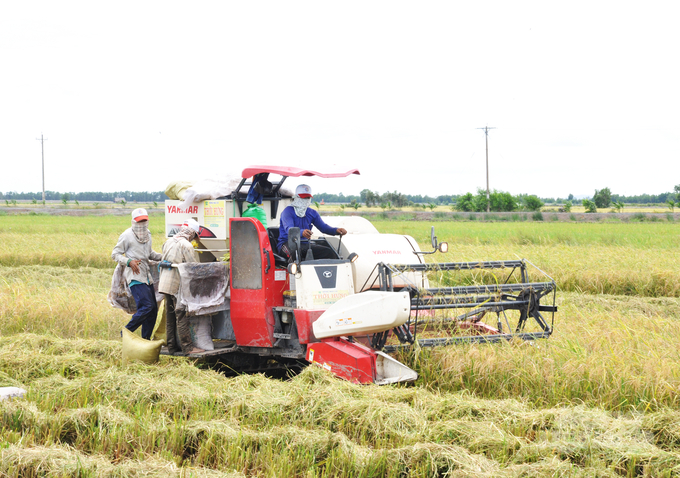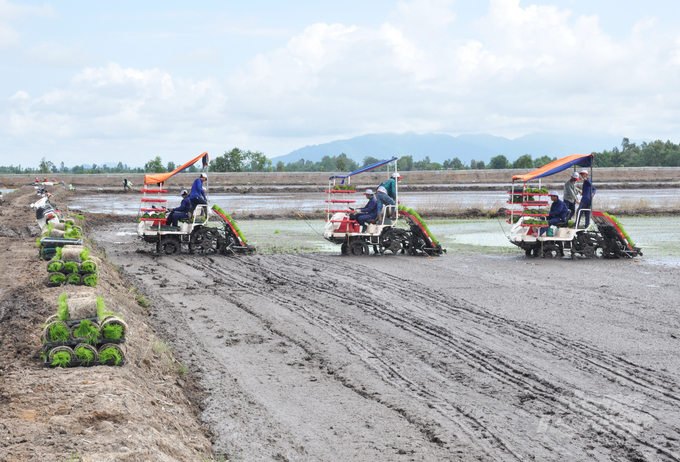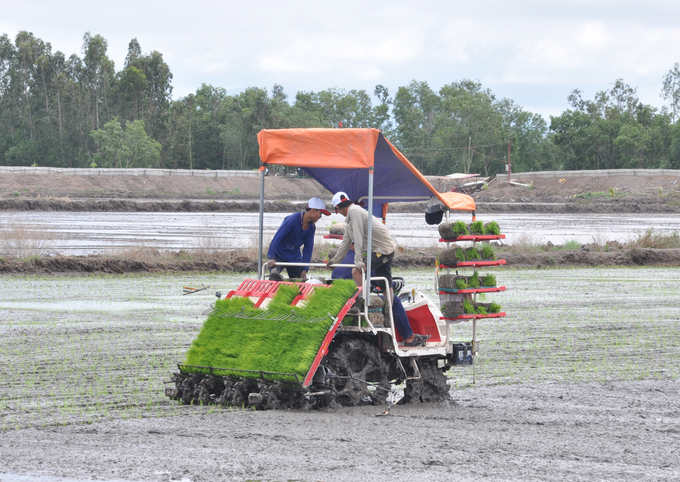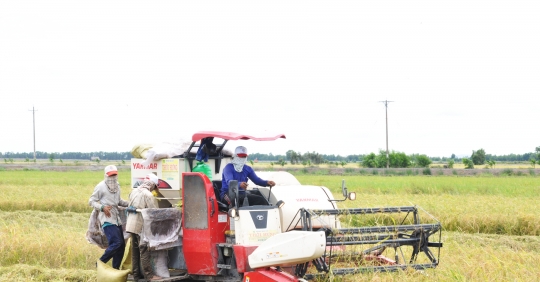Spectacular transformation
The Mekong Delta, after hundreds of years of developing the land, has become the country’s largest rice granary built out of his father’s wet-rice civilization. Through the country’s history of ups and downs, from the northern delta to the central coast to the southwestern region, rice has provided a solid livelihood, bringing food and warm clothing to millions of farmers. .
On the rice journey, the image of farmers and villages in our country seems to be forever associated with “the buffalo goes first, the plow follows”, all year round the story of hard work and hard work “face for the land sell, sell with his back to the sky” depending on the crop. But perhaps since the appearance of the plow in the field to replace the buffalo, he has marked a spectacular transformation that is constantly progressing.

Combine harvester on a large field in the Mekong Delta. Photo: Hu Duc.
From the second half of the twentieth century plows began to appear more and more in the fields of the West. Since then, there has been continuous work to improve and manufacture mechanical agricultural implements to replace the power to pull buffalo and cows and reduce the hardship for farmers. Initially, the plow ran well, turned the land well, brought out dozens of buffalo in the dry field, and made the farmers happy. Not long after, other tillers appeared, sowing harrows and seed suitable for small fields ahead of the rainy season. The buffalo herd gradually retreated to distant fields where the ground was low, the foothills of the fields deep and muddy.
The basic mechanization of tillage has been solved. This was followed by the introduction of a variety of walk-behind and mechanized farming equipment for the stages of sowing, fertilizing, spraying pesticides, maintaining and improving the quality of rice seeds, and liberating farmers from manual labor.
Towards the end of the twentieth century, agronomists said that the greatest achievement of the “green revolution” was increasing Vietnam’s rice production not only through mastery of seed technology, but also through the mechanization of rice cultivation. In the there are machine manufacturers with automatic equipment and farmers who innovate and produce agricultural machines that meet the needs in the production process and are suitable for any terrain in the region.
Field mechanization has shown a significant increase in productivity and contributed to the miraculous transformation. The yield and quality of raw material rice are constantly improving. It is living proof that the application of new technology always motivates a leading rice producer in the world.
Highlights of Agritechnica Asia Live
At the end of August 2022, the international event Agritechnica Asia Live 2022 with the theme “Synchronized Mechanization Towards Sustainable Agriculture” was jointly organized by the Ministry of Agriculture and Rural Development and the International Rice Research Institute (IRRI) in Can Tho City. and the German Agricultural Society (DLG).

The operation of the rice planting machine is suitable in a large field in the Mekong Delta Photo: Hu Duc.
For the first time, farmers in the Mekong Delta have access to modern agricultural technologies from countries with advanced industrial and agricultural production. The most prominent activities were demonstrations of production methods, technologies and agricultural machines in the field in the fields of cultivation, animal husbandry, aquaculture, forestry, post-harvest treatment, processing of agricultural products and food…
Along the banks of the Mekong Delta Rice Institute’s experimental paddy fields, hundreds of typical farmers from the region’s provinces took to the fields to see the demonstration machines firsthand. Rice transplanters, aircraft seeding equipment, fertilisers, pesticides or intelligent irrigation systems – the 4.0 model adapts to climate change… while discussing the direction of creating an agricultural mechanics center in the Mekong Delta in the future.
This is the crystallization from the process of agricultural restructuring in the Mekong Delta, which is taking place in parallel with the mechanization of the fields and further motivates the professional rice farmers in the face of rural labor relocation and climate change adaptation. One of the typical turning points is the effect of bringing the combine harvester successfully to the field, which is highly appreciated by international rice experts. This is really a “revolution” to solve the problem of reducing the loss rate and harvesting rice in a large field at the same time. Harvesters have so far covered the entire Mekong Delta.
A couple of concerns
Although Mekong Delta farmers have made many achievements in applying technical advances and rapid advances in rice production mechanization, agricultural experts still have concerns. Mechanization has not spread evenly and synchronously, so it is not satisfied with the achievements. According to a survey by the University of Agriculture and Forestry in Ho Chi Minh City, the proportion of farmers who own tractors and agricultural machinery is still small, on average about 50 households have a tractor, much less than in other countries.

Up to now, the Mekong Delta has mechanized almost 100% of the land preparation phase. Photo: tsp.
The application of agricultural mechanization has only increased rapidly in the last 10 years. According to the Ministry of Economic Cooperation and Rural Development, in the period 2011-2021, the number of all kinds of tractors will increase by 60%, water pumps by 60%, combine harvesters by 80% and agricultural dryers by 30%. , Animal feed processing increased by 91%, Aqua feed processing increased by 2.2 times, Pesticide sprayers increased by 3.5 times, Planting machines increased by 10 times… Especially for Mekong Delta rice, the level is the Soil preparation 100%, sowing and transplanting 75%, plant care and protection 85%, harvest 95% and straw and straw collection 90%…
The Mekong Delta region currently has a limitation of mechanization in post-harvest storage, making the loss rate more than 10% and the corresponding annual loss is estimated at about US$550 million.
On the other hand, at the sowing stage, how to reduce the amount of seed sown, reduce fertilizers, pesticides is still a problem that has not been fully resolved. Habits from the long-term practice of growing rice and soybean orchids still occupy a large space. In the past 3 years, the Mekong Delta Rice Institute, in cooperation with the Agricultural Advisory Center of Soc Trang, Tien Giang and Hau Giang Provinces, has enthusiastically responded to the application model of tray plating planter in rice production.

Rice seeder in the sowing season in the Mekong Delta. Photo: Hu Duc.
Experienced farmer Hua Thanh Nghia in Dai Tam Municipality, My Xuyen District (Soc Trang), specializes in growing rice seeds, and briefly calculated the efficiency problem: if you want to produce seeds that are pure, not mixed, the transplant method is the best. . However, it is too difficult to find workers for hand transplants and the cost is very high. The benefit of the transplanter is far greater, as the maximum seed rate is reduced to 60-70%, rice has few pests and diseases, so the cost of fertilizers and pesticides is reduced to VND 3.5-4 million/ha, while the Yield is low, rice yield increased to around 500 kg/ha. Golden rice, solid grain…
MSc Nguyen Ngoc Hoang, Head of Department of Agricultural Mechatronics (Mekong Delta Rice Institute), who directly participates in central agricultural extension projects on the application of mechanization of rice production, commented: At present, the majority of farmers in the Mekong Delta also use the sowing method (about 80%).
Affected by climate change, salinity intrusion takes place very complicated, which has had a significant impact on the rice cultivation process, causing farmers to worry about harvest timing, yield and production costs. Therefore, planting machine start-up is a necessary necessity, a solution to increase rice production efficiency, reduce time in the field and avoid unwanted damage from natural disasters.

